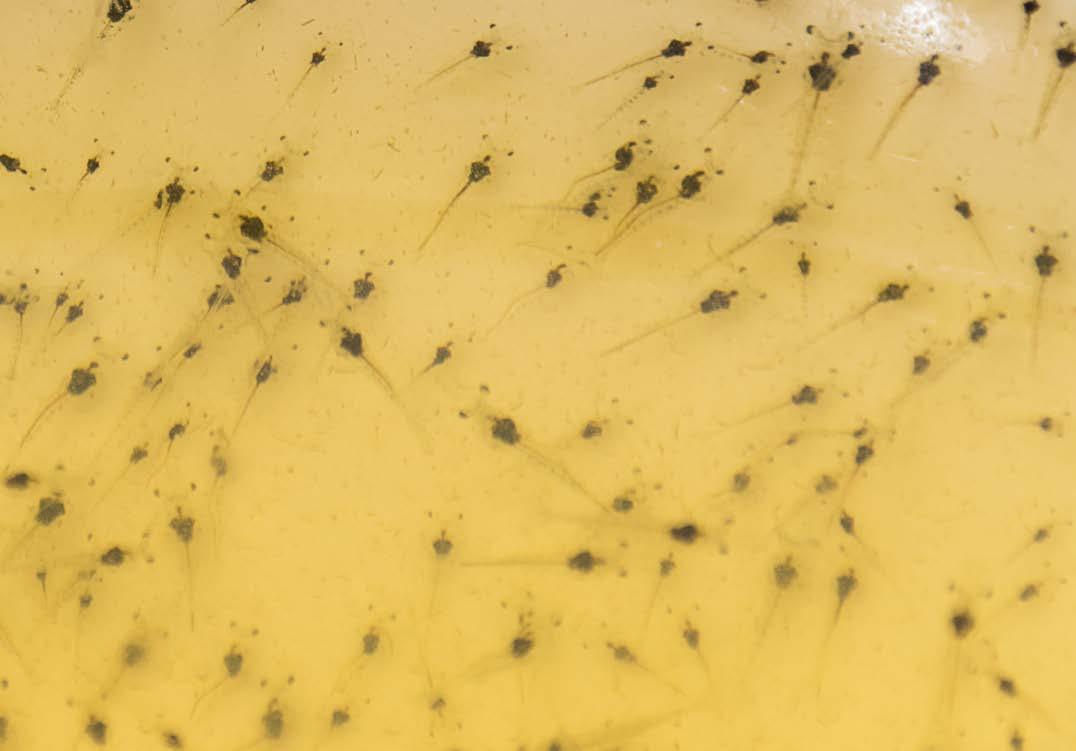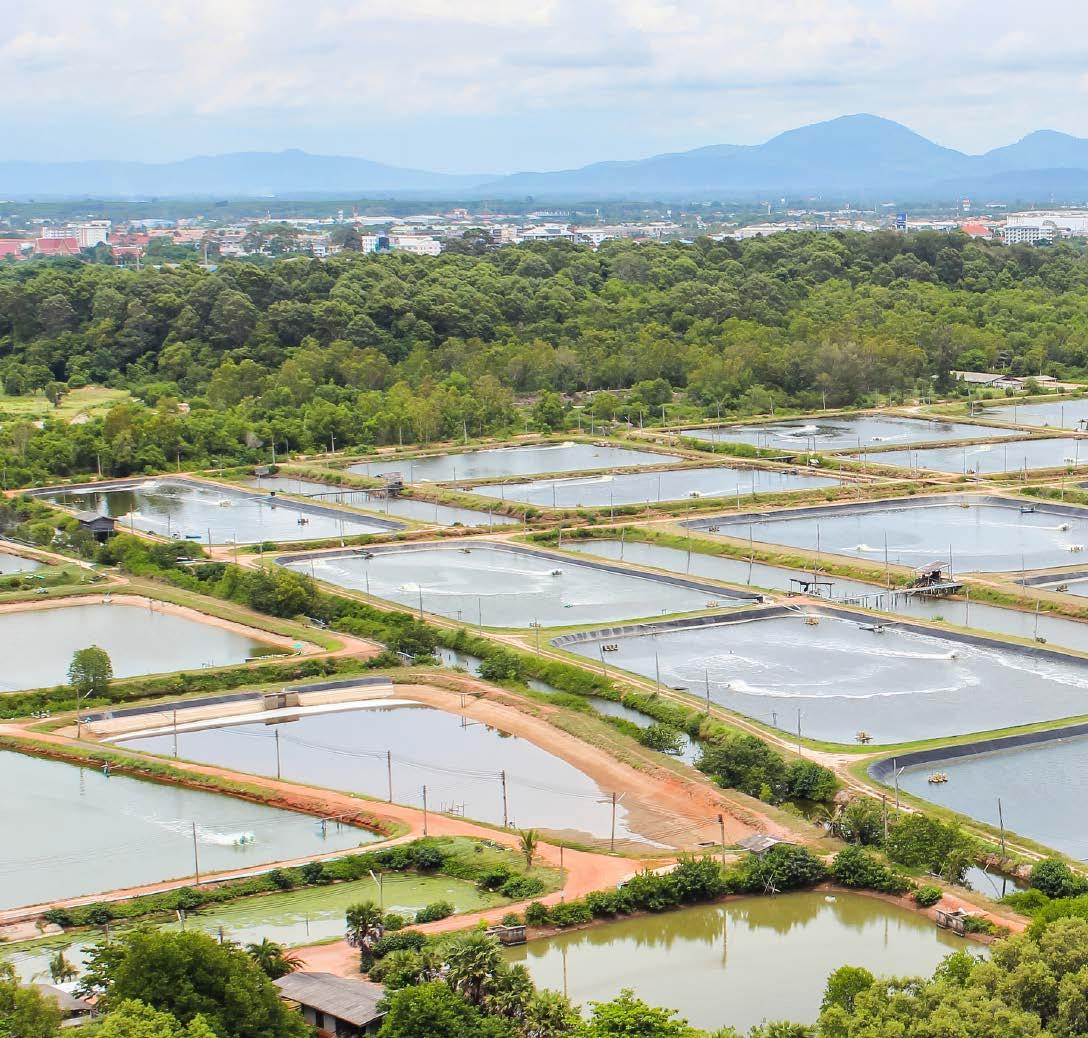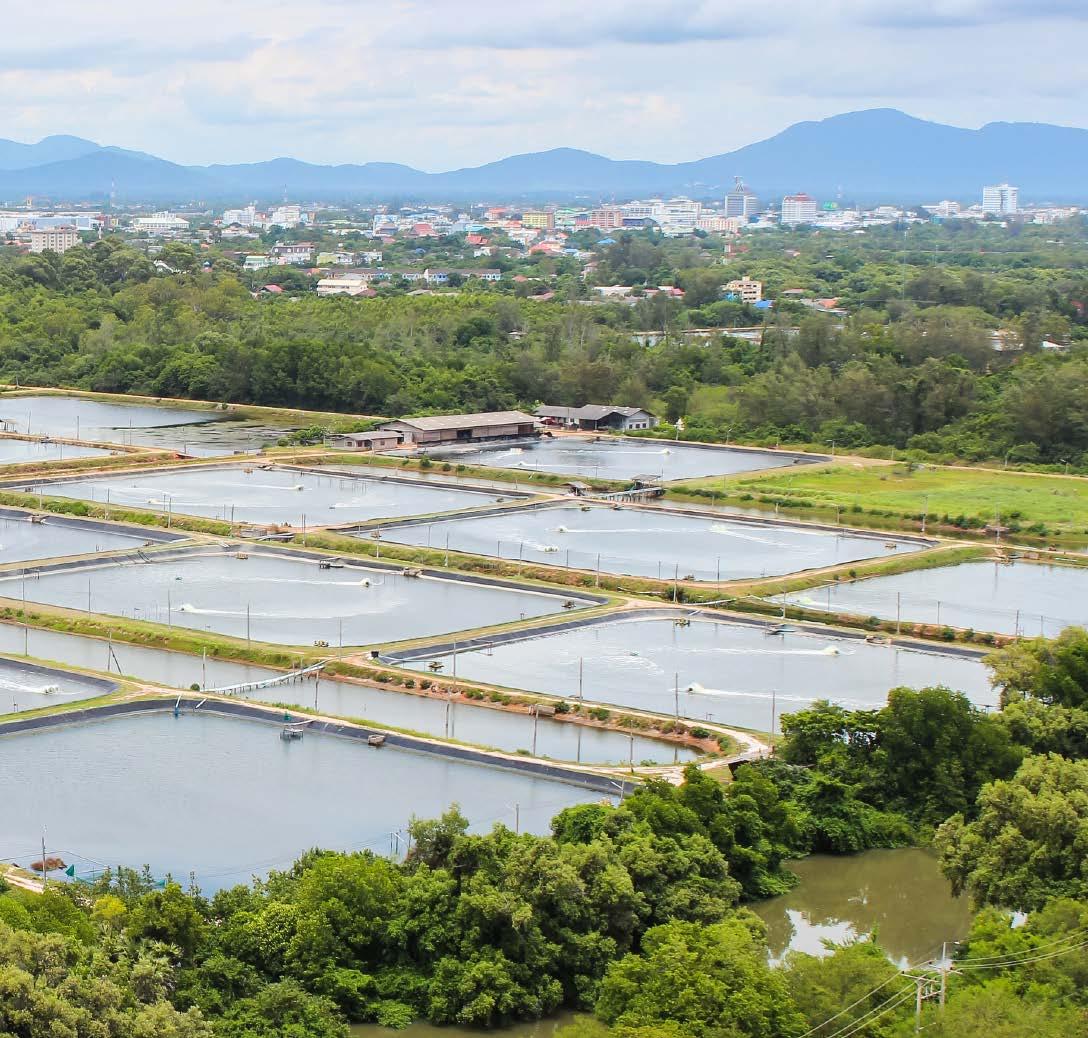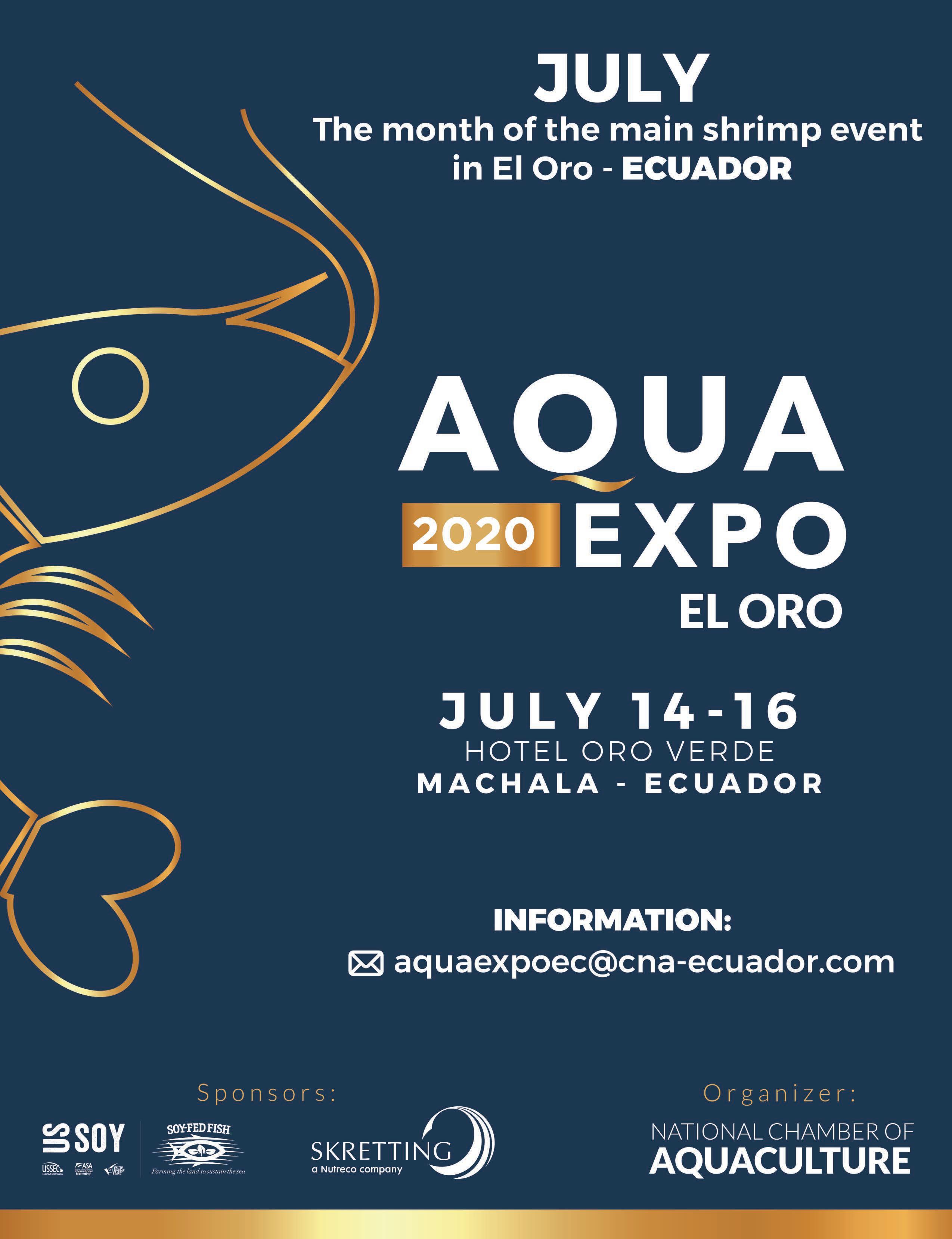
13 minute read
THE GOOD, THE BAD AND THE UGLY
THE GOOD, THE BAD AND THE UGLY Biosecurity challenges facing China (and shrimp farmers everywhere)
By: Ph.D Stephen G. Newman*
Disease is natural. The absence of disease is not. This requires that steps must be taken to lessen the potential impacts of disease on production in order to ensure sustainability. As the industry has evolved towards paradigms that allow for maximum production, such as super high-density culture in lined ponds, disease runs rampant and hardly a year goes by when we do not hear about a new disease being reported.
Wild Chinese polychaetes are a serious biosecurity risk yet everybody tells you that “they are too good not to use.”
The portion of the above in quotes is from an anonymous broodstock provider in China and is a common comment. Chinese farmed shrimp production (largely L. vannamei today although others are also being routinely farmed) has declined steadily over the last several decades. Official numbers are in the 1.5 million MT plus range per year. Actual production is, by all accounts of those on the ground, less, although the presence of large artisanal production areas away from the coastal regions makes it probable that no one can accurately know what is being produced. Given the increased rate of imports, China is not able to meet its local demand.
Much of my comments in this article relate to shrimp farming anywhere. It is not my intent to single China out only to point out how easy it is to get caught in a way of thinking that is not consistent with sustain
ability. Although shrimp have been “farmed” for millennia, even today, there are farmers in some parts of the world who use similar approaches. High tides carry a variety of marine fish and invertebrates into impoundments. The densities are low, and they are not always fed processed feeds. In today’s world this paradigm is too slowly disappearing and is being replaced by production systems that are more in tune with the science of aquaculture designed to maximize production and thus profits. Aerators, formulated feeds, automatic feeders are just a few of the tools that are in use. The economics of high-density culture systems, when they work, is compelling and the move towards these systems is slow but inexorable.
As I have written many times, disease is natural. The absence of disease is not. This requires that steps must be taken to lessen the potential impacts of disease on production in order to ensure sustainability. Attitudes that ensure animal health issues persist are the norm and there are far too many who farm shrimp with little or no concern about controlling the entry of pathogens into their production systems (China is certainly NOT the only country where this is an issue). As the industry has evolved towards paradigms that allow for maximum production, such as super high-density culture in lined ponds, disease runs rampant and hardly a year goes by when we do not hear about a new disease being reported.
Farmed shrimp are a commodity. The market is global and not merely local. The law of supply and demand determines the price farmers are being paid. When the demand exceeds the supply of shrimp the prices are driven higher. Higher prices allow farmers to be less exacting in their production. They can lose animals to preventable diseases and still make money. As the lure of potential windfall profits drives increases in production, the resultant supply exceeds the demand, driving prices down. Those farmers, and there are too many, who are marginal, fail. Those with sufficient resources can just not stock or stock at lower densities and wait the economic cycle out. This, for the most part is the state of the global shrimp farming community. A constant push and pull driven by supply and demand.
China has been the world’s leading producer of farmed shrimp for many decades. Even today if the official production numbers are real, they would still dwarf that of the world’s next highest producers. In my discus- sions with those in China, who would know, I have been told that the actual production might be a third of what the claimed production figures are. As farms have intensified, increases in disease and the generation of new pathogens have dampened production.
Again, to be clear, many of the issues discussed here persist everywhere that shrimp are farmed. I have spent some time in China working with the industry at all levels and my conclusions are that the average farmer cares more about making money in the short term than they do about ensuring that production is sustainable. Notably, the apparent lack of environmental regulations ensures high levels of water pollution and contributes to the transmission of pathogens to stressed animals. Until these are addressed, I am not optimistic that China will see a healthy industry. In fact, overall production will more than likely continue to decline until production paradigms evolve that mitigate these problems. Highly controlled indoor production systems do offer some potential.
There is a however a “fly in the ointment”. A major source of patho

gens in production systems is from post larval shrimp. Carryover of pathogens from maturation, many experts believe, is responsible for much of the disease. There are many avenues for this although wild feeds needed to ensure high levels of fecundity are a major source of this.
In China, the use of live polychaetes in maturation is a major source of pathogens including AHPNS and EHP, WSSV and other viral pathogens. When you ask about their use, the invariable response is that there are great advantages that come from using them (higher fecundity translates into more PLs to sell because of poor survivals in the hatchery). This is a huge hole in biosecurity that must be addressed. Even in a highly bio secure environment that precludes pathogens from entering, this gap in biosecurity must be closed.
The development of a tool that can detect miniscule amounts of DNA or RNA, known by the acronym PCR (which refers to the enzyme that is instrumental in this process-a polymerase) is a significant advance in the rapid detection of pathogens that can cause mortality. Early in the development of this technology it was also used in aquaculture. For animals with individual high value, each animal can be tested. However, since fish (and shrimp) typically have little
value as individuals and we are often dealing with populations that range from the thousands to millions, a statistical approach was employed. This entails sampling subsets of a given population. The American Fisheries Society publishes a blue book that outlines what levels of a population needed to be tested to ensure a given level of sensitivity. It is assumed that the test itself is highly accurate (specific and sensitive) and that the population being tested is sampled at random. If these criteria are met, then the best that one can hope to achieve is to be able to state with confidence that 98% of the sample’s population is free of a given pathogen (when 150 individual animals are tested out of population of 100000 or more). The truth is that this level of confidence is rarely met and that we are more than likely in the 5 to 10% range.

Sampling a small percentage of the population and pooling samples reduces the sensitivity of the assay. Broodstock that are not held from cradle to grave in highly bio secure conditions (indoors in controlled environments, limited access by personnel, the use of live feeds that are not sterilized, etc.) cannot be assumed to be free of any given pathogen even when PCR results come back negative (if they have been tested on a population and not an individual basis). The only way to be confident that pathogens are not present is to test each individual for all known pathogens of concern. The technology exists to do this today and those who shirk from doing this testing are more or less ensuring that they perpetuate animal health issues on the farm. There can be no sustainability unless this is addressed.

As with other persistent myths in aquaculture, many assumed that a negative PCR result meant that the populations sampled were negative for the pathogen. Even if all of the aforementioned criteria for testing were met (which is NEVER the case) it only means that the samples are negative. This “weakness” in PCR testing combined with the apparent lack of concern and/or comprehension about what role failure to adequately test spawning adults plays in disease transmission, explains many problems that the global industry experiences to this day.
The widespread belief that a 98% level of confidence that a given pathogen may not be present in the population based on a small subsample of large populations has caused untold misery and financial hardships. Most companies who produce post larval shrimp claim that their animals are free of pathogens based on this. Even if this were real it would still mean that out of every million PLs, 20,000 could be carrying the pathogen that one is screening for. At the 5 to 10% levels 50,000 to 100,000 could be carriers. This has been a pathway to disaster and has cost many hatchery owners and shrimp farmers their livelihoods.
Until such a time as there is widespread recognition that this is the reality there is little hope of anything changing. Every individual broodstock should be tested (Genics Pty Ltd. offers a multiplex PCR that tests for multiple pathogens in a single sample for less than $50 per sample). While some might think that this is still too expensive to justify testing every individual broodstock, the reality is that there is no other way to eliminate many potential pathogens from the typical production environments without this approach. While no method is always going to be 100%, closing this gap as much as possible is critical for sustainable production.
The bottom line in all of this is that a persistent belief that is based on short term gain can show the way towards rectifying the situation. Willfully using wild polychaetes which are known to be carrying many potential viral pathogens of shrimp and as with most animals many of their own should be a red flag. The additional costs of using bio secure sources of polychaetes may not increase the bottom line of broodstock producers but reducing and eliminating all overt potential sources of the introduction of potential pathogens into the farm will, in most cases, increase the profitability of farms. Individual screening of broodstock will help reduce the risks that producers face. These are easy places to start and well worth the benefit: eliminating the use of contaminated feed, testing each animal for a panel of pathogens and enforced environmental regulations that ensure a high quality environment for both shrimp and the humans that eat them can do nothing in the long run but improve production and allow China once again to take its place as the world’s uncontested leader in the farming of shrimp.
Stephen G. Newman has a bachelor’s degree from the University of Maryland in Conservation and Resource Management (ecology) and a Ph.D. from the University of Miami, in Marine Microbiology. He has over 40 years of experience working within a range of topics and approaches on aquaculture such as water quality, animal health, biosecurity with special focus on shrimp and salmonids. He founded Aquaintech in 1996 and continues to be CEO of this company to the present day. It is heavily focused on providing consulting services around the world on microbial technologies and biosecurity issues. sgnewm@aqua-in-tech.com www.aqua-in-tech.com www.bioremediationaquaculture.com www.sustainablegreenaquaculture.com
Upcoming aquaculture events
OCTOBER 2020 DECEMBER 2020 AUGUST 2021 15° FIACUI – INTERNATIONAL AQUACULTURE FORUM WORLD AQUACULTURE 2020 WORLD SEAFOOD INDUSTRY 2020
Sep. 29 – Oct. 02 Dec. 14 – Dec. 18 Aug. 25 – Aug. 27 Chiapas, Mexico Singapore, Singapore Guadalajara, Jalisco, Mexico T: +52 1 331 466 0392 T: +1 760 751 5005 T: +52 1 331 466 0392 E: crm@dpinternationalinc.com E: worldaqua@aol.com E: crm@dpinternationalinc.com W: www.panoramaacuicola.com W: www.was.org W: www.panoramaacuicola.com
NOVEMBER 2020 3rd. INTERNATIONAL MARICULTURE SYMPOSIUM
Nov. 5 – Nov. 6 La Paz, Mexico T: +52 1 331 466 0392 E: crm@dpinternationalinc.com W: www.panoramaacuicola.com
AQUACULTURE AFRICA 2020
Nov. 28 – Dec. 1 Alexandria, Egypt. T: +1 760 751 5005 E: worldaqua@aol.com W: africanchapter@was.org
MARCH 2021 AQUASUR 2020
Exact dates to be confirmed Puerto Montt, Chile E: info@aqua-sur.cl W: www.aqua-sur.cl
APRIL 2021 AQUACULTURE EUROPE 2020
Apr. 12 – Apr. 15 Cork, Ireland T: +1 760 751 5005 E: worldaqua@aol.com W: www.was.org
AERATION EQUIPMENT, PUMPS, FILTERS AND MEASURING INSTRUMENTS, ETC
AQUATIC EQUIPMENT AND DESIGN, INC.....................................19 522 S. HUNT CLUB BLVD, #416, APOPKA, FL 32703. USA. Contact: Amy Stone T: (407) 717-6174 E-mail: amy@aquaticed.com DELTA HYDRONICS LLC...............................................................13 T: 727 861 2421 www.deltahydro.com FRESH FLO....................................................................................9 3037 Weeden Creek Rd. Sheboygan, WI 53081, USA Contact: Barb Ziegelbauer T: 800 493 3040 E-mail: barb@freshflo.com www.freshflo.com
ANTIBIOTICS, PROBIOTICS AND FEED ADDITIVES
MEGASSUPPLY............................................................................23 USA, Europe, South America, Asia y Middle East. Tel.: +1 (786) 221 5660 Fax: +1 (786) 524 0208 www.megasupply.net
EVENTS AND EXHIBITIONS
3TH INTERNATIONAL SYMPOSIUM ON MARICULTURE 2020...........................................................51 November 5 – 6, 2020. La Paz, BCS, Mexico. T: +52 1 331 466 0392 E: crm@dpinternationalinc.com W: www.panoramaacuicola.com 6 TH SCIENCE AND TECHNOLOGY CONFERENCE ON SHRIMP FARMING 2021...................................................................25 January 28 – 29, 2021. Cd. Obregón, Sonora, Mexico. T: +52 1 331 466 0392 E: crm@dpinternationalinc.com W: www.panoramaacuicola.com AQUACULTURE AMERICA 2021 SAN ANTONIO..............................7 February 21 - 24, 2021.San Antonio Texas, USA. Tel: +1 760 751 5005 E-mail: worldaqua@aol.com www.was.org
advertisers Index
AQUAEXPO EL ORO 2020........................INSIDE BACK COVER 14 al 16 de Juliio, 2020. Machala, Ecuador. E-mail: aquaexpoec@cna-ecuador.com T: (04) 268 3017 ext. 202 AQUAEXPO GUAYAQUIL 2020..............................................31 26 al 29 de Octubre, 2020. Guayaquil, Ecuador. E-mail: aquaexpoec@cna-ecuador.com 15° FIACUI..........................................................INSIDE COVER October 8 - 9, 2020. Chiapas, Mexico. T: +52 1 331 466 0392 E: crm@dpinternationalinc.com W: www.panoramaacuicola.com GUATEMALA AQUALCULTURE SYMPOSIUM 2020...................21 Cooming Soon, 2020. Santo Domingo del Cerro, La Antigua Guatemala, Guatemala. E: simposiodeacuiculturagt@agexport.org.gt W: www.simposio.acuiculturaypescaenguatemala.com LAQUA 2020..................................................................................1 22 - 25 de march, 2021. Guayaquil, Ecuador. Tel: +1 760 751 5005 E-mail: worldaqua@aol.com www.was.org
INFORMATION SERVICES
PANORAMA ACUÍCOLA MAGAZINE Empresarios No. #135 Int. Piso 7 Oficina 723 Col. Puerta de Hierro, C.P.45116 Zapopan, Jal. México Office: +52 (33) 8000 0578 Contact 1: Subscriptions E-mail: suscripciones@panoramaacuicola.com Office: +52 (33) 8000 0629 y (33) 8000 0653 Contact 2: Juan Carlos Elizalde, Sales & Marketing Coordinator. crm@dpinternationalinc.com | Cell: +521 33 1466 0392 Contact 3: Claudia Marín, Sales Support Expert E-mail: sse@dpinternationalinc.com www.panoramaacuicola.com
AQUACULTURE MAGAZINE...................5, 57, BACK COVER Design Publications International Inc. 203 S. St. Mary’s St. Ste. 160 San Antonio, TX 78205, USA Office: +210 504 3642 Office in Mexico: +52(33) 8000 0578 - Ext: 8578 Subscriptions: iwantasubscription@dpinternationalinc.com Sales & Marketing Coordinator. Juan Carlos Elizalde crm@dpinternationalinc.com | Cell: +521 33 1466 0392 Sales Support Expert, Claudia Marín sse@dpinternationalinc.com | Cell:+521 333 968 8515
AQUAFEED.COM..........................................................................79 Web portal · Newsletters · Magazine · Conferences · Technical Consulting. www.aquafeed.com AQUA IN TECH, INC......................................................................11 6722 162nd Place SW, Lynnwood, WA, USA. Contact: Stephen Newman. T: (+1) 425 787 5218 E-mail: sgnewm@aqua-in-tech.com
TANKS AND NETWORKING FOR AQUACULTURE
REEF INDUSTRIES..................................................................33 9209 Almeda Genoa Road Z.C. 7075, Houston, Texas, USA. Contact: Gina Quevedo/Mark Young/ Jeff Garza. T: Toll Free 1 (800) 231-6074 T: Local (713) 507-4250 E-mail: gquevedo@reefindustries.com / jgarza@reefindustries.com / myoung@reefindustries.com www.reefindustries.com







